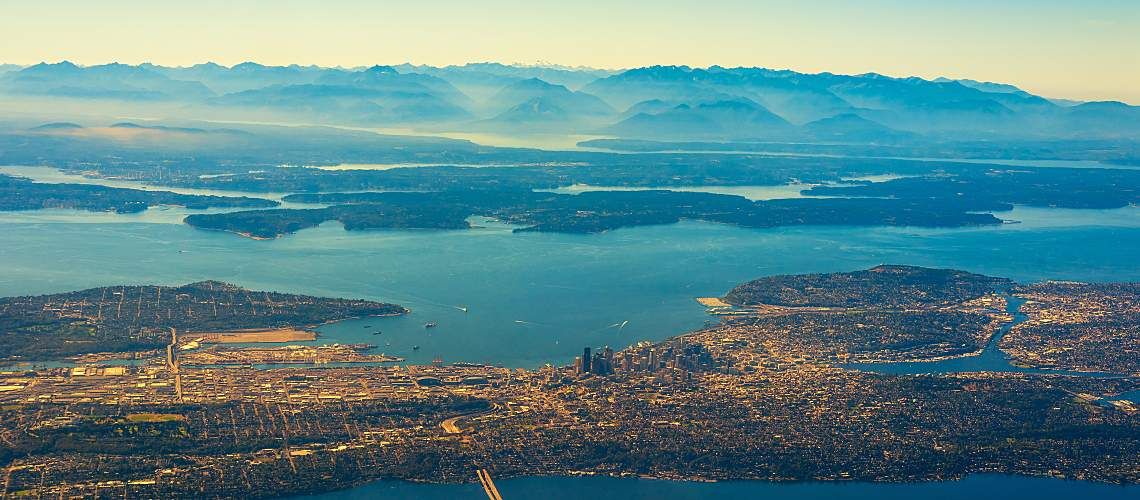Trading Sewage Could Save Puget Sound Water Quality and Marine Life


Although it's often known for its stunning beauty and abundant marine life, much of Puget Sound is plagued with oxygen levels too low to sustain fish and other aquatic organisms. That's due in part to discharges of nutrient-rich sewage from domestic wastewater treatment plants (WWTPs).
To address the major sources of nutrient releases, the Washington State Department of Ecology issued the Puget Sound Nutrient General Permit (PSNGP) in December 2021. WWTP modifications since have improved the nutrient situation—but not enough. Meeting the stringent limits would require many WWTPs to make a significant investment in treatment infrastructure.
To reduce nutrients more quickly and efficiently, the Washington State Legislature allocated $350,000 for the Ecology Department to investigate a nutrient credit trading program among the 58 WWTPs covered under the PSNGP. Other states have also introduced trading as a market-based way to help reach water quality goals.
Here's a closer look at the way sewage depletes oxygen in water, the requirements for a cap-and-trade program, and the department's recommendations for Washington's program.
From Too Much Nitrogen to Too Little Oxygen
Excess nutrients in WWTP sewage, especially nitrogen, act like fertilizer to feed algal and aquatic plant growth. When the vegetation dies, decomposition uses up oxygen in the water. According to Washington's Ecology Department, 9% of Puget Sound's nitrogen comes from WWTPs, agriculture, and stormwater runoff. The resulting low oxygen levels in many parts of the Sound are below the state's water quality criteria and the concentrations needed by marine life, according to a June 2023 Ecology Department Report.
As the state's population grows, so does the problem—prompting the department to develop a Nutrient Reduction Plan to curtail the various human sources of nutrient pollution. WWTPs must control nutrients per the PSNGP to comply with the federal Clean Water Act and Washington's Water Pollution Control Act.

Achieving Healthy Oxygen Levels Via Cap and Trade
A nutrient trading program similar to Washington's carbon pricing system is one possibility for tackling the issue. Water quality trading assigns an improvement value—a "credit"—to pollution reduction activities. WWTPs can trade credits on a local market. The Environmental Protection Agency supports trading as an efficient and flexible approach to achieving water quality goals on a watershed basis.
Under the proposed nutrient trading program, each WWTP would be assigned a permitted level of nutrient releases. Plants discharging above permitted levels could buy credits from others with concentrations below permitted levels. But first, the plant must cut high nutrient levels to a specified concentration with its own equipment.
Nutrient-Related Upgrades at WWTPs
The LOTT Clean Water Alliance shows both the cost and impact of nutrient reduction improvements. The plant in Olympia, Wash., recently completed a $30 million project focused primarily on nutrient-related upgrades.
After screening, incoming fluids now flow through a series of concrete basins, where microorganisms transform nitrogen compounds from one form to another and eventually to nitrogen gas, which dissipates into the atmosphere. The water undergoes further screening and disinfection before it's released into Budd Inlet. After the improvements, LOTT treatment performance is among the best in the country and routinely better than what's required by permit.
But not knowing how nutrient limits will change in the future makes upgrades to manage them a conundrum. For WWTPs not designed for nutrient removal, improvements could cost ratepayers hundreds of dollars each month. Washington is currently studying how much nitrogen is healthy for Puget Sound and how much inflow should be allowed from individual plants and locations starting with the 2027 PSNGP.
Recommendations for Cap and Trade
Washington's Ecology Department made several key recommendations for the initial phase of a water quality trading program in Puget Sound. Continual re-evaluation will incorporate future permit limits, modeling results, and funding.
- Trading program structure: The department recommended limiting initial trading only to WWTPs covered under the PSNGP. In addition, the program must develop trade ratios and geographic boundaries to mitigate risks and uncertainties related to facility performance, potential impacts on areas with limited oxygen, and localized water quality problems. Permittees would be responsible for negotiating trades, but the department would assist by developing resource documents. The department would also evaluate compliance with permits and verify credits prior to exchanges.
- Regulatory considerations: The Ecology Department proposed establishing trading program provisions through the PSNGP and modifying water quality offset regulations to clearly define the department's authority to run the program. Above all, the department recommended rules for trading be simple.
- Tribal consultation: The department must work with Washington's Native Tribes and consider potential program impacts on fishing and shellfish harvesting areas and reservation waters. To do so effectively requires a formal tribal engagement plan.
- Stakeholder engagement: Likewise, the department recommended a stakeholder engagement plan to identify goals, opportunities, and timelines for action.
- Funding: The Ecology Department noted the program requires stable funding through legislative appropriations. The cost would be too high to expect ratepayers alone to support the program through PSNGP permit fees.
What's next for the nutrient trading program in Washington? First, its Ecology Department must gauge the interest of WWTPs in the program. Assuming a positive response, the legislature needs to agree to fund the recommendations made in the June 2023 report. Then the department must establish nitrogen limits for 2027-2031, develop tribal and stakeholder engagement plans, and confirm their authority to administer a trading program.






